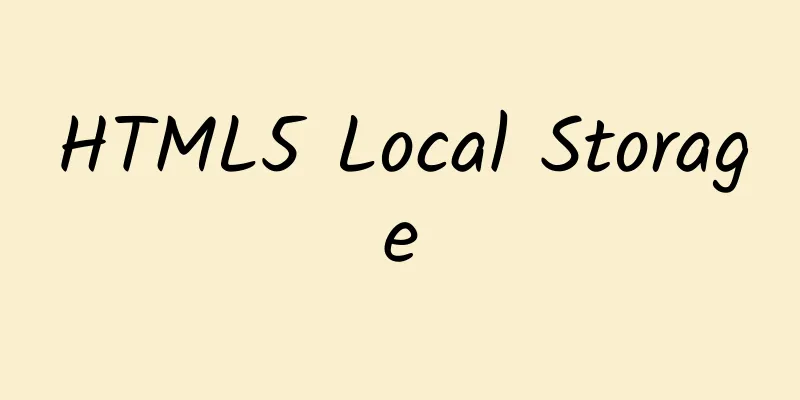|
[[145256]] What is localstorage A few days ago, I found some strange operations on cookies in an old project. After consulting, I found that some information was cached to avoid passing parameters on the URL, but I didn’t consider what problems cookies would bring: - The cookie size is limited to about 4k, which is not suitable for storing business data
- Cookies are sent with each HTTP transaction, wasting bandwidth
We are working on a mobile project, so the technology that is really suitable for use here is localstorage. Localstorage can be said to be an optimization of cookies. It can be used to store data on the client and will not be transmitted with HTTP, but it is not without problems: - The localstorage size limit is about 5 million characters, and it varies from browser to browser.
- localstorage is not readable in privacy mode
- The essence of localstorage is to read and write files. If there is a lot of data, it will be slow (Firefox will import the data into the memory at once, which is scary to think about)
- localstorage cannot be crawled by crawlers, so don't use it to completely replace URL parameter passing
The above problems can be avoided, so our focus should be on how to use localstorage and how to use it correctly. Use of localstorage Basics There are two types of localstorage storage objects: ① sessionStrage: session means conversation. Here, session refers to the time period from when a user browses a website to when he or she closes the website. The validity period of the session object is only this long. ② localStorage: Save the data on the client hardware device, no matter what it is, which means that the data will still be there when you turn on the computer next time. The difference between the two is that one is for temporary storage and the other is for long-term storage. Here is a simple code to illustrate its basic use: - < div id = "msg" style ="margin: 10px 0; border: 1px solid black; padding: 10px; width: 300px;
- height: 100px;" >
- </ div >
- < input type = "text" id = "text" />
- < select id = "type" >
- < option value = "session" > sessionStorage </ option >
- < option value = "local" > localStorage </ option >
- </ select >
- < button onclick = "save();" >
- Save data </ button >
- < button onclick = "load();" >
- Read data </ button >
- < script type = "text/javascript" >
- var msg = document .getElementById('msg'),
- text = document .getElementById('text'),
- type = document .getElementById('type');
-
- function save() {
- var str = text.value ;
- var t = type.value ;
- if ( t == 'session') {
- sessionStorage.setItem('msg', str);
- } else {
- localStorage.setItem('msg', str);
- }
- }
-
- function load() {
- var t = type.value ;
- if ( t == 'session') {
- msg.innerHTML = sessionStorage .getItem('msg');
- } else {
- msg.innerHTML = localStorage .getItem('msg');
- }
- }
- </ script >
Real-world scenarios In actual work, the use of localstorage generally has the following requirements: ① Cache general information, such as the departure city, arrival city, and non-real-time location information on the search page ② Cache city list data, which is often large ③ Each cached information needs to be traceable. For example, when the server notifies the city data to be updated, it should automatically expire when it is last accessed. ④ Each piece of information has an expiration date, and the server needs to pull data outside the expiration date ⑤ ...... - define([], function () {
-
- var Storage = _.inherit({
-
- properties: function () {
-
-
- this .sProxy = window.localStorage;
-
-
- this .defaultLifeTime = 2592000000 ;
-
-
- this .keyCache = 'SYSTEM_KEY_TIMEOUT_MAP' ;
-
-
- this .removeNum = 5 ;
-
- },
-
- assert : function () {
- if ( this .sProxy === null ) {
- throw 'not override sProxy property' ;
- }
- },
-
- initialize: function (opts) {
- this .propertys();
- this . assert ();
- },
-
-
-
-
-
-
-
- set: function (key, value, timeout, sign) {
- var _d = new Date();
-
- var indate = _d.getTime();
-
-
- var entity = null ;
-
- if (!timeout) {
- _d.setTime(_d.getTime() + this .defaultLifeTime);
- timeout = _d.getTime();
- }
-
-
- this .setKeyCache(key, timeout);
- entity = this .buildStorageObj(value, indate, timeout, sign);
-
- try {
- this .sProxy.setItem(key, JSON.stringify(entity));
- return true ;
- } catch (e) {
-
- if (e.name == 'QuotaExceededError' ) {
-
-
- if (! this .removeLastCache()) throw 'The amount of data stored this time is too large' ;
- this .set(key, value, timeout, sign);
- }
- console && console.log(e);
- }
- return false ;
- },
-
-
- removeOverdueCache: function () {
- var tmpObj = null , i, len;
-
- var now = new Date().getTime();
-
- var cacheStr = this .sProxy.getItem( this .keyCache);
- var cacheMap = [];
- var newMap = [];
- if (!cacheStr) {
- return ;
- }
-
- cacheMap = JSON.parse(cacheStr);
-
- for (i = 0 , len = cacheMap.length; i < len; i++) {
- tmpObj = cacheMap[i];
- if (tmpObj.timeout < now) {
- this .sProxy.removeItem(tmpObj.key);
- } else {
- newMap.push(tmpObj);
- }
- }
- this .sProxy.setItem( this .keyCache, JSON.stringify(newMap));
-
- },
-
- removeLastCache: function () {
- var i, len;
- var num = this .removeNum || 5 ;
-
-
- var cacheStr = this .sProxy.getItem( this .keyCache);
- var cacheMap = [];
- var delMap = [];
-
-
- if (!cacheStr) return false ;
-
- cacheMap.sort(function (a, b) {
- return a.timeout - b.timeout;
- });
-
-
- delMap = cacheMap.splice( 0 , num);
- for (i = 0 , len = delMap.length; i < len; i++) {
- this .sProxy.removeItem(delMap[i].key);
- }
-
- this .sProxy.setItem( this .keyCache, JSON.stringify(cacheMap));
- return true ;
- },
-
- setKeyCache: function (key, timeout) {
- if (!key || !timeout || timeout < new Date().getTime()) return ;
- var i, len, tmpObj;
-
-
- var oldstr = this .sProxy.getItem( this .keyCache);
- var oldMap = [];
-
- var flag = false ;
- var obj = {};
- obj.key = key;
- obj.timeout = timeout;
-
- if (oldstr) {
- oldMap = JSON.parse(oldstr);
- if (!_.isArray(oldMap)) oldMap = [];
- }
-
- for (i = 0 , len = oldMap.length; i < len; i++) {
- tmpObj = oldMap[i];
- if (tmpObj.key == key) {
- oldMap[i] = obj;
- flag = true ;
- break ;
- }
- }
- if (!flag) oldMap.push(obj);
-
- this .sProxy.setItem( this .keyCache, JSON.stringify(oldMap));
-
- },
-
- buildStorageObj: function (value, indate, timeout, sign) {
- var obj = {
- value: value,
- timeout: timeout,
- sign: sign,
- indate: indate
- };
- return obj;
- },
-
- get: function (key, sign) {
- var result, now = new Date().getTime();
- try {
- result = this .sProxy.getItem(key);
- if (!result) return null ;
- result = JSON.parse(result);
-
-
- if (result.timeout < now) return null ;
-
-
- if (sign) {
- if (sign === result.sign)
- return result.value;
- return null ;
- } else {
- return result.value;
- }
-
- } catch (e) {
- console && console.log(e);
- }
- return null ;
- },
-
-
- getSign: function (key) {
- var result, sign = null ;
- try {
- result = this .sProxy.getItem(key);
- if (result) {
- result = JSON.parse(result);
- sign = result && result.sign
- }
- } catch (e) {
- console && console.log(e);
- }
- return sign;
- },
-
- remove: function (key) {
- return this .sProxy.removeItem(key);
- },
-
- clear: function () {
- this .sProxy.clear();
- }
- });
-
- Storage.getInstance = function () {
- if ( this .instance ) {
- return this .instance;
- } else {
- return this .instance = new this ();
- }
- };
-
- return Storage;
-
- });
This code contains the basic operations of localstorage and handles the above problems, but the actual use needs to be abstracted further: - define([ 'AbstractStorage' ], function (AbstractStorage) {
-
- var Store = _.inherit({
-
- properties: function () {
-
-
- this .key = null ;
-
-
- this .lifeTime = '30M' ;
-
-
-
-
-
- this .sProxy = new AbstractStorage();
-
- },
-
- setOption: function (options) {
- _.extend( this , options);
- },
-
- assert : function () {
- if ( this .key === null ) {
- throw 'not override key property' ;
- }
- if ( this .sProxy === null ) {
- throw 'not override sProxy property' ;
- }
- },
-
- initialize: function (opts) {
- this .propertys();
- this .setOption(opts);
- this . assert ();
- },
-
- _getLifeTime: function () {
- var timeout = 0 ;
- var str = this .lifeTime;
- var unit = str.charAt(str.length - 1 );
- var num = str.substring( 0 , str.length - 1 );
- var Map = {
- D: 86400 ,
- H: 3600 ,
- M: 60 ,
- S: 1
- };
- if (typeof unit == 'string' ) {
- unit = unit.toUpperCase();
- }
- timeout = num;
- if (unit) timeout = Map[unit];
-
-
- return num * timeout * 1000 ;
- },
-
-
- set: function (value, sign) {
-
- var timeout = new Date();
- timeout.setTime(timeout.getTime() + this ._getLifeTime());
- this .sProxy.set( this .key, value, timeout.getTime(), sign);
- },
-
-
- setAttr: function (name, value, sign) {
- var key, obj;
- if (_.isObject(name)) {
- for (key in name) {
- if (name.hasOwnProperty(key)) this .setAttr(k, name[k], value);
- }
- return ;
- }
-
- if (!sign) sign = this .getSign();
-
-
- obj = this .get(sign) || {};
- if (!obj) return ;
- obj[name] = value;
- this .set(obj, sign);
-
- },
-
- getSign: function () {
- return this .sProxy.getSign( this .key);
- },
-
- remove: function () {
- this .sProxy.remove( this .key);
- },
-
- removeAttr: function (attrName) {
- var obj = this .get() || {};
- if (obj[attrName]) {
- delete obj[attrName];
- }
- this .set(obj);
- },
-
- get: function (sign) {
- var result = [], isEmpty = true , a;
- var obj = this .sProxy.get( this .key, sign);
- var type = typeof obj;
- var o = { 'string' : true , 'number' : true , 'boolean' : true };
- if (o[type]) return obj;
-
- if (_.isArray(obj)) {
- for (var i = 0 , len = obj.length; i < len; i++) {
- result[i] = obj[i];
- }
- } else if (_.isObject(obj)) {
- result = obj;
- }
-
- for (a in result) {
- isEmpty = false ;
- break ;
- }
- return !isEmpty ? result : null ;
- },
-
- getAttr: function (attrName, tag) {
- var obj = this .get(tag);
- var attrVal = null ;
- if (obj) {
- attrVal = obj[attrName];
- }
- return attrVal;
- }
-
- });
-
- Store.getInstance = function () {
- if ( this .instance ) {
- return this .instance;
- } else {
- return this .instance = new this ();
- }
- };
-
- return Store;
- });
When we actually use it, we use the store class to operate localstorage. The code ends with a simple test: The storage is completed and no requests will be made in the future, so today's code is basically finished. other In privacy mode, window.name can be used to simulate sessionStorage, because window.name can be saved, which is also the reason why it solves the cross-domain solution. There is a back button in Android Hybrid. Once pressed, it will return to the previous page. At this time, the localstorage in it may be invalid! A simple but unreliable solution is to add in the webapp: - window.onunload = function () { };
Conclusion Localstorage is an essential technical point for mobile development, which requires in-depth understanding. The specific business code will be put on git later. Interested friends can go to learn more |










